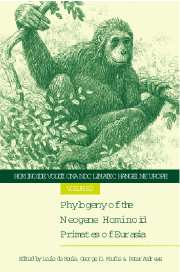 Hominoid Evolution and Climatic Change in Europe
Hominoid Evolution and Climatic Change in Europe Book contents
- Frontmatter
- Contents
- List of Contributors
- Acknowledgements: The European Science Foundation
- PART I: Chronology and environment
- PART II: Methods and phylogeny
- 3 Computer-assisted morphometry of hominoid fossils: the role of morphometric maps
- 4 Comparative analysis of the iliac trabecular architecture in extant and fossil primates by means of digital image processing techniques: implications for the reconstruction of fossil locomotor behaviours
- 5 Dental microwear and diet in Eurasian Miocene catarrhines
- 6 How reliable are current estimates of fossil catarrhine phylogeny? An assessment using extant great apes and Old World monkeys
- 7 Cranial discrete variation in the great apes: new prospects in palaeoprimatology
- PART III Miocone hominoids: function and phylogeny
- Index
3 - Computer-assisted morphometry of hominoid fossils: the role of morphometric maps
from PART II: Methods and phylogeny
Published online by Cambridge University Press: 06 January 2010
- Frontmatter
- Contents
- List of Contributors
- Acknowledgements: The European Science Foundation
- PART I: Chronology and environment
- PART II: Methods and phylogeny
- 3 Computer-assisted morphometry of hominoid fossils: the role of morphometric maps
- 4 Comparative analysis of the iliac trabecular architecture in extant and fossil primates by means of digital image processing techniques: implications for the reconstruction of fossil locomotor behaviours
- 5 Dental microwear and diet in Eurasian Miocene catarrhines
- 6 How reliable are current estimates of fossil catarrhine phylogeny? An assessment using extant great apes and Old World monkeys
- 7 Cranial discrete variation in the great apes: new prospects in palaeoprimatology
- PART III Miocone hominoids: function and phylogeny
- Index
Summary
Introduction
In the past decades, the rapid evolution of computer-based technologies has opened up a wide range of novel applications in the biosciences, notably in areas where large volumes of data must be acquired and analysed. Within the scope of potential computer-assisted applications, paleoanthropology is a particularly challenging field – due to the extreme scarcity of fossil remains and the fragmentary preservation of most specimens, the data base is both limited and incomplete. It is therefore of vital interest to expand the available evidence, not only by adding recently discovered specimens to the present sample, but also by devising novel methods that permit extraction of a maximum of information from the sparse material.
Computer-based procedures have already proven especially useful in tapping new sources of information within the sample of fossil hominoids. Special-purpose computer tools for the acquisition, processing and visualisation of 3-dimensional data of fossil specimens have been integrated into a methodological framework given the label computer-assisted paleoanthropology (CAP, Zollikofer et al., 1998). CAP is based on a combination of three technologies: computer tomography, computer graphics and stereolithograpy (Figure 3.1). Computer tomography (CT) has revolutionised non-invasive data acquisition by providing X-ray based cross-sectional images of solid objects. In medical diagnostics, CT has become a standard tool and, likewise, in palaeoanthropology, CT scanning is extensively used for ‘fossil diagnostics’, notably to reveal internal anatomical features and regions still covered by matrix (Conroy & Vannier, 1984; Zonneveld & Wind, 1985; Conroy, 1991). Going one step beyond imaging, CT scanners also serve as powerful tools for the acquisition of 3-dimensional data – by merging a series of consecutive cross-sectional images, a graphical representation of an entire fossil specimen can be reconstructed.
- Type
- Chapter
- Information
- Hominoid Evolution and Climatic Change in EuropePhylogeny of the Neogene Hominoid Primates of Eurasia, pp. 50 - 59Publisher: Cambridge University PressPrint publication year: 2001
- 7
- Cited by


